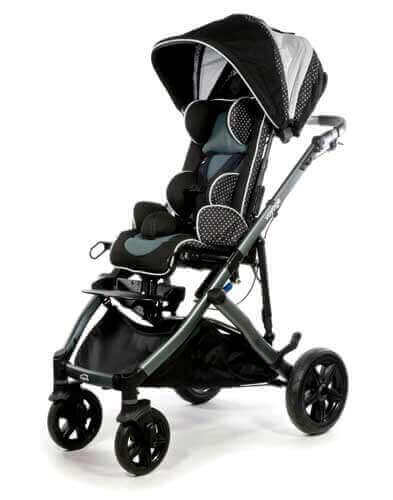Teilen:
Take it offline!
This Education in Motion resource is also available as a printable PDF.
Download PDF
In many cases, recommending a mobility device for an infant who is dependent on a caregiver to be moved from place to place is straightforward. After all, a six-month old with or without a neuromuscular disorder is expected to need a buggy for mobility in the community. As babies grow into toddlers, preschoolers, children, and through adolescence, the decision between a dependent and independent mobility device for an individual with disabilities can become a bit more complex. If you haven't done so already, be sure to read How to Select a Dependent Mobility Device: Identifying Needs.
At the end of Part 1 of this series, Linda mentioned that there are three overarching categories of dependent mobility devices: adaptive strollers, transit wheelchairs, and manual wheelchairs (tilt-in-space and standard). In this post, we are going to take a closer look at the two categories of dependent mobility devices that can fall under the umbrella of complex rehab technology: adaptive strollers and manual wheelchairs.
Adaptive Strollers
According to Merriam Webster's dictionary, a stroller (i.e. buggy) in the context of a wheeled mobility device is defined to be a "collapsible carriage designed as a chair in which a small child can be pushed." An adaptive buggy (in some cases referred to as an early intervention stroller), is intended to be a collapsible mobility device for infants and young children who need more support or components secondary to physical or medical needs.

While some adaptive buggies look and function similarly to standard/mainstream buggies, it's common for caregivers to be resistant to the idea of an adaptive buggy for an infant or young child. Reasons may include lack of knowledge that these devices exist, concerns about funding, convenience and practicality for use, difficulty accepting their child's diagnosis, and/or the belief the child can "make do" with a standard stroller purchased prior to the child's birth. However, an adaptive stroller with components to support proper positioning and safely accommodate vital medical equipment can be life-changing for the child's overall growth and development.
An adaptive stroller such as the ZIPPIE Voyage may include these features:
- Moderate-to-complex postural supports to facilitate the best position of the child from head to toe.
- Built-in adjustments to support growth.
- Seat tilt and recline for position changes to facilitate activity participation, respiratory needs, eating, digestion, resting, etc.
- Ability to change the seat position from caregiver-facing to forward-facing.
- Options for transport: easily foldable to store in the trunk of a vehicle and crash tested for occupant transit.
- Vent tray, IV pole, storage bins, canopies, etc.
Manual Wheelchairs
There are a few subcategories that fall under manual wheelchairs. The two most common in CRT are ultra lightweight wheelchairs and tilt-in-space wheelchairs.
Ultra lightweight wheelchairs

Oftentimes when envisioning an individual who is appropriate to utilize an ultra lightweight wheelchair, the image of an independent active user who sustained a spinal cord injury pops into our heads. However, some ultra lightweight wheelchairs can be configured in ways that are appropriate for someone who is dependent for propulsion. For example, a Quickie Life might be the best wheelchair for a client who is unable to propel himself independently, needs a lower seat-to-floor height in the rear, and a specific back angle, but doesn't need dynamic tilt.
Tilt-in-space wheelchairs
The term "tilt-in-space" refers to when the entire chair shifts its position on its frame as one unit, while maintaining the angles of hips, knees, and ankles. There are a variety of clinical benefits and justifications as to why a client may need tilt as an option on his wheelchair, including: improving posture, aiding functional activities and interaction, allowing for weight shifts and position changes, helping with redistributing pressure from the pelvis to the trunk, improving respiratory status, aiding digestion, etc. If you'd like to learn more about tilt, I highly recommend reading The Science of Manual Tilt and Clinical Benefits of Tilt.
In Sunrise Medical's portfolio of products, we offer tilt-in-space wheelchairs with dynamic or static tilt. Dynamic tilt allows for the seat of the wheelchair to be tilt fluidly throughout a specific range. For example, a ZIPPIE IRIS with 55 degrees of tilt allows for the user to be positioned at -5° to 50° or 0° to 55° dynamically via activation of the tilt mechanism. Whereas wheelchair with static tilt, allows for use of a tilt set angle to support posture.

Dynamic Tilt
There are a number of additional considerations to keep in mind besides determining if the client needs a tilt-in-space wheelchair, including:
- Seating components to provide optimal positioning and support from head to toe.
- Need for a reclining back.
- Style of dynamic tilt mechanism: fixed pivot point vs. rotation in space.
- Way in which tilt is adjusted: fluid via a trigger or foot pedal, or manual adjustment to set angles.
- Transport options: ability to be folded for transport in trunk and/or crash tested for occupant transit.
- Need for functional add-ons to the wheelchair such as a vent tray, IV pole, storage baskets, canopy, etc.